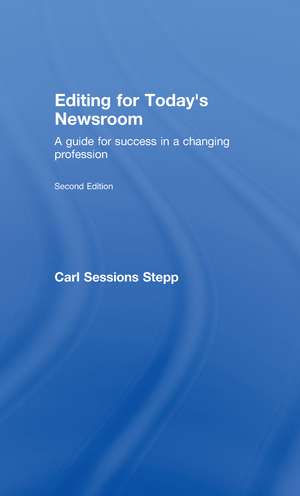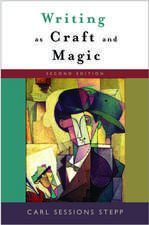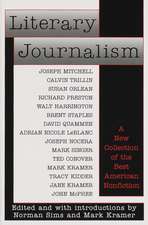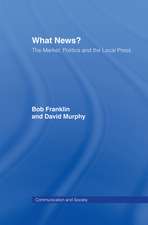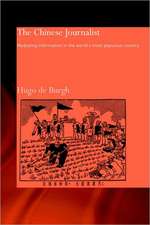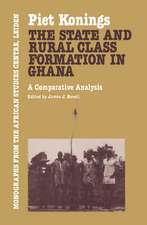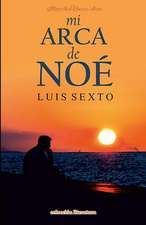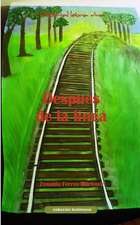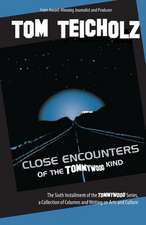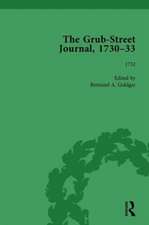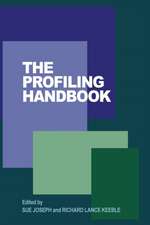Editing for Today's Newsroom: A Guide for Success in a Changing Profession: Routledge Communication Series
Autor Carl Sessions Steppen Limba Engleză Hardback – 6 iun 2008
| Toate formatele și edițiile | Preț | Express |
|---|---|---|
| Paperback (1) | 423.09 lei 6-8 săpt. | |
| Taylor & Francis – 6 iun 2008 | 423.09 lei 6-8 săpt. | |
| Hardback (1) | 1006.07 lei 6-8 săpt. | |
| Taylor & Francis – 6 iun 2008 | 1006.07 lei 6-8 săpt. |
Din seria Routledge Communication Series
-
 Preț: 156.78 lei
Preț: 156.78 lei - 9%
 Preț: 575.54 lei
Preț: 575.54 lei -
 Preț: 155.43 lei
Preț: 155.43 lei - 8%
 Preț: 441.77 lei
Preț: 441.77 lei - 8%
 Preț: 415.39 lei
Preț: 415.39 lei - 9%
 Preț: 576.43 lei
Preț: 576.43 lei - 15%
 Preț: 404.22 lei
Preț: 404.22 lei - 8%
 Preț: 495.22 lei
Preț: 495.22 lei - 8%
 Preț: 509.90 lei
Preț: 509.90 lei -
 Preț: 392.96 lei
Preț: 392.96 lei - 8%
 Preț: 516.77 lei
Preț: 516.77 lei - 8%
 Preț: 460.12 lei
Preț: 460.12 lei - 8%
 Preț: 394.36 lei
Preț: 394.36 lei -
 Preț: 424.75 lei
Preț: 424.75 lei - 15%
 Preț: 431.10 lei
Preț: 431.10 lei -
 Preț: 364.94 lei
Preț: 364.94 lei -
 Preț: 363.96 lei
Preț: 363.96 lei - 22%
 Preț: 325.34 lei
Preț: 325.34 lei - 15%
 Preț: 463.49 lei
Preț: 463.49 lei - 15%
 Preț: 464.31 lei
Preț: 464.31 lei -
 Preț: 366.85 lei
Preț: 366.85 lei -
 Preț: 264.53 lei
Preț: 264.53 lei - 16%
 Preț: 247.75 lei
Preț: 247.75 lei -
 Preț: 354.28 lei
Preț: 354.28 lei -
 Preț: 374.27 lei
Preț: 374.27 lei - 22%
 Preț: 321.54 lei
Preț: 321.54 lei -
 Preț: 418.13 lei
Preț: 418.13 lei -
 Preț: 481.52 lei
Preț: 481.52 lei -
 Preț: 442.50 lei
Preț: 442.50 lei -
 Preț: 498.91 lei
Preț: 498.91 lei -
 Preț: 369.95 lei
Preț: 369.95 lei - 24%
 Preț: 133.28 lei
Preț: 133.28 lei - 31%
 Preț: 325.43 lei
Preț: 325.43 lei - 25%
 Preț: 769.37 lei
Preț: 769.37 lei -
 Preț: 447.05 lei
Preț: 447.05 lei - 18%
 Preț: 722.88 lei
Preț: 722.88 lei -
 Preț: 389.60 lei
Preț: 389.60 lei -
 Preț: 249.75 lei
Preț: 249.75 lei -
 Preț: 395.37 lei
Preț: 395.37 lei -
 Preț: 363.96 lei
Preț: 363.96 lei - 18%
 Preț: 1004.72 lei
Preț: 1004.72 lei - 18%
 Preț: 998.71 lei
Preț: 998.71 lei -
 Preț: 380.22 lei
Preț: 380.22 lei - 26%
 Preț: 243.26 lei
Preț: 243.26 lei -
 Preț: 97.53 lei
Preț: 97.53 lei -
 Preț: 242.11 lei
Preț: 242.11 lei - 20%
 Preț: 402.68 lei
Preț: 402.68 lei -
 Preț: 226.33 lei
Preț: 226.33 lei -
 Preț: 386.14 lei
Preț: 386.14 lei -
 Preț: 241.09 lei
Preț: 241.09 lei
Preț: 1006.07 lei
Preț vechi: 1226.91 lei
-18% Nou
Puncte Express: 1509
Preț estimativ în valută:
192.51€ • 201.54$ • 159.29£
192.51€ • 201.54$ • 159.29£
Carte tipărită la comandă
Livrare economică 05-19 aprilie
Preluare comenzi: 021 569.72.76
Specificații
ISBN-13: 9780805862171
ISBN-10: 080586217X
Pagini: 248
Ilustrații: black & white illustrations
Dimensiuni: 152 x 229 x 20 mm
Greutate: 0.62 kg
Ediția:Revizuită
Editura: Taylor & Francis
Colecția Routledge
Seria Routledge Communication Series
Locul publicării:Oxford, United Kingdom
ISBN-10: 080586217X
Pagini: 248
Ilustrații: black & white illustrations
Dimensiuni: 152 x 229 x 20 mm
Greutate: 0.62 kg
Ediția:Revizuită
Editura: Taylor & Francis
Colecția Routledge
Seria Routledge Communication Series
Locul publicării:Oxford, United Kingdom
Cuprins
Contents
Preface xi
1 The Changing World of Editing
The Chronic Shortage of Editors 6
Lifestyles of the Nonrich and the Nonfamous 7
The Changing Nature of Journalism 11
Conclusion 14
Sidebar 1—Experiences in Editing 15
2 The Rise of the New Editor 21
The Editor in History 22
The Editor As Businessperson 26
The Editor As Planner 29
The Editor As Manager 30
The Editor As Journalist 31
Conclusion 33
Sidebar 2—Defining the Typical Editor: "How Come So
Many of Them Tend to be Geeks?"
by David Barry 34
3 What Is an Editor? 38
How Writers See Editors 39
How Editors See Themselves 43
What Makes a Good Editor 45
Sidebar 3—Gifts
by Charles McCorkle Hauser 51
4 The Editor As Decision Maker 54
Making Decisions: The Foundation 55
Properly Equipping the Newsroom 56
Strategically Allocating Time 57
Setting a Tone for Good Communications 60
Shaping a Personal Decision-Making Model 61
Conclusion 62
Sidebar 4—Human Perversity
from Editor & Publisher 63
5 Making Decisions About People 64
Managing in Today’s Newsroom 64
Leading Other Journalists 76
Conclusion 79
Sidebar 5—Editors Muse on Their Management Style
from the ASNE Bulletin 80
6 Making Decisions About Coverage 83
What News Is and Isn’t 84
Organizing Coverage 87
Conclusion 92
Sidebar 6—Sure Ways to Become
the World’s Worst Editor
by Carl Sessions Stepp 93
7 Making Decisions About Copy 95
A Model for Editing 97
Conclusion 114
Sidebar 7—10 Steps Toward Better Editing
by Carl Sessions Stepp 114
8 Making Decisions About Design 116
Headlines 118
Photos 121
Graphics 123
Layout 125
Conclusion 129
Sidebar 8—The New Age of Graphics
by Bill Steinauer 130
9 Making Decisions About Legal Issues 134
Libel 137
Invasion of Privacy 141
Courts and Contempt 142
Plagiarism and Copyright 145
National Security 146
Conclusion 148
Sidebar 9—An Editor’s Reading List 149
10 Making Decisions About Ethics 151
The Ethics of Day-to-Day Journalism 153
The Ethics of Newsroom Policymaking 158
The Ethics of Upper Management 162
Conclusion 165 Sidebar 10—Excerpts From "Newsroom
Policies and Guidelines"
from the Seattle Times 165
11 Toward Excellence in Editing 169
Developing New Editors 171
Nurturing Editors 175
Some Specific Starting Points 178
Conclusion: To the Future 179
Appendix: Helping Writers With Form 180
Spelling 180
Grammar and Punctuation 181
Usage 183
Helping Writers With Style and Form 185
A Checklist 187
Index 188
Preface xi
1 The Changing World of Editing
The Chronic Shortage of Editors 6
Lifestyles of the Nonrich and the Nonfamous 7
The Changing Nature of Journalism 11
Conclusion 14
Sidebar 1—Experiences in Editing 15
2 The Rise of the New Editor 21
The Editor in History 22
The Editor As Businessperson 26
The Editor As Planner 29
The Editor As Manager 30
The Editor As Journalist 31
Conclusion 33
Sidebar 2—Defining the Typical Editor: "How Come So
Many of Them Tend to be Geeks?"
by David Barry 34
3 What Is an Editor? 38
How Writers See Editors 39
How Editors See Themselves 43
What Makes a Good Editor 45
Sidebar 3—Gifts
by Charles McCorkle Hauser 51
4 The Editor As Decision Maker 54
Making Decisions: The Foundation 55
Properly Equipping the Newsroom 56
Strategically Allocating Time 57
Setting a Tone for Good Communications 60
Shaping a Personal Decision-Making Model 61
Conclusion 62
Sidebar 4—Human Perversity
from Editor & Publisher 63
5 Making Decisions About People 64
Managing in Today’s Newsroom 64
Leading Other Journalists 76
Conclusion 79
Sidebar 5—Editors Muse on Their Management Style
from the ASNE Bulletin 80
6 Making Decisions About Coverage 83
What News Is and Isn’t 84
Organizing Coverage 87
Conclusion 92
Sidebar 6—Sure Ways to Become
the World’s Worst Editor
by Carl Sessions Stepp 93
7 Making Decisions About Copy 95
A Model for Editing 97
Conclusion 114
Sidebar 7—10 Steps Toward Better Editing
by Carl Sessions Stepp 114
8 Making Decisions About Design 116
Headlines 118
Photos 121
Graphics 123
Layout 125
Conclusion 129
Sidebar 8—The New Age of Graphics
by Bill Steinauer 130
9 Making Decisions About Legal Issues 134
Libel 137
Invasion of Privacy 141
Courts and Contempt 142
Plagiarism and Copyright 145
National Security 146
Conclusion 148
Sidebar 9—An Editor’s Reading List 149
10 Making Decisions About Ethics 151
The Ethics of Day-to-Day Journalism 153
The Ethics of Newsroom Policymaking 158
The Ethics of Upper Management 162
Conclusion 165 Sidebar 10—Excerpts From "Newsroom
Policies and Guidelines"
from the Seattle Times 165
11 Toward Excellence in Editing 169
Developing New Editors 171
Nurturing Editors 175
Some Specific Starting Points 178
Conclusion: To the Future 179
Appendix: Helping Writers With Form 180
Spelling 180
Grammar and Punctuation 181
Usage 183
Helping Writers With Style and Form 185
A Checklist 187
Index 188
Recenzii
Carl Sessions Stepp’s second edition of Editing for Today’s Newsroom arrives at just the right time. In today’s "anyone can be a journalist" environment, Stepp reminds us that editors and editing stand between journalistic mediocrity and excellence. Readers will find crisp technique, context and encouragement in this coherent, accessible text. Certain to emerge as the standard.
John F. Greenman, University of Georgia
Carl Stepp thoroughly understands every phase of editing. He knows editing’s past and present, and, most importantly, he leads us toward its future. Editing for Today’s Newsroom provides insightful point-by-point guidance on everything from applying basic grammar rules to making decisions about coverage.
This book will inspire the college student working toward his first rim job. It will restore confidence to the veteran desk person struggling to keep pace with a growing demand for speed (Don’t miss Carl’s discussion of the RECESS method). It will encourage a veteran reporter just promoted to a seat on the city desk. And it will motivate a longtime editor who’s striving to provide leadership in the changing newsroom environment. Anyone who edits, studies editing or teaches aspiring editors should read Editing for Today’s Newsroom.
Bill Cloud, Julian W. Scheer Term Associate Professor and director of the Summer Institute for Midcareer Copy Editors, University of North Carolina at Chapel Hill
A young editor once asked Carl Sessions Stepp whether editing was a job or a lifestyle. Stepp’s answer is this book, which covers the "breathtaking breadth" of editing as a way of life. Updated to reflect journalism’s transformation by the Internet, Editing for Today’s Newsroom is a guide to the job of editing in all its roles: leader, coach, quality controller, umpire – even, thanks to the linking nature of online journalism, brand manager. Stepp pulls powerful examples of the best and worst editors from his own career, as well as from the experiences of other professionals, to leave readers chuckling – and sometimes flinching, occasionally quaking. In the end, students of editing, novice and pro alike, are deeply impressed by the imperative to focus on the heart of editing – making news decisions that are grounded in fact and fairness and helping writers to express their ideas in the most effective way possible. If future editors heed the wisdom in this book, journalism’s future will be in surer hands.
Deborah Gump, Committee of Concerned Journalists
"[...] Here is what you should know about Stepp's second edition of Editing for Today's Newsroom: Buy it, read it, and savor it as a passionate testimony to, and a practical handbook for, editors everywhere."
-- Jan Leach, Journalism and Mass Communication Quarterly
"Readers will enjoy the bonus vignettes, short slices of real newsroom insight, such as proceedings from a paper's news meeting, problems student editors have dealt with, recommendations from former editors, cases, debates, and newsroom lore."
-- Jan Leach, Journalism and Mass Communication Quarterly
"This book should be circulated in newsrooms and classrooms to help energize and inspire editors; they deserve to celebrate the joy that is journalism."
-- Jan Leach, Journalism and Mass Communication Quarterly
John F. Greenman, University of Georgia
Carl Stepp thoroughly understands every phase of editing. He knows editing’s past and present, and, most importantly, he leads us toward its future. Editing for Today’s Newsroom provides insightful point-by-point guidance on everything from applying basic grammar rules to making decisions about coverage.
This book will inspire the college student working toward his first rim job. It will restore confidence to the veteran desk person struggling to keep pace with a growing demand for speed (Don’t miss Carl’s discussion of the RECESS method). It will encourage a veteran reporter just promoted to a seat on the city desk. And it will motivate a longtime editor who’s striving to provide leadership in the changing newsroom environment. Anyone who edits, studies editing or teaches aspiring editors should read Editing for Today’s Newsroom.
Bill Cloud, Julian W. Scheer Term Associate Professor and director of the Summer Institute for Midcareer Copy Editors, University of North Carolina at Chapel Hill
A young editor once asked Carl Sessions Stepp whether editing was a job or a lifestyle. Stepp’s answer is this book, which covers the "breathtaking breadth" of editing as a way of life. Updated to reflect journalism’s transformation by the Internet, Editing for Today’s Newsroom is a guide to the job of editing in all its roles: leader, coach, quality controller, umpire – even, thanks to the linking nature of online journalism, brand manager. Stepp pulls powerful examples of the best and worst editors from his own career, as well as from the experiences of other professionals, to leave readers chuckling – and sometimes flinching, occasionally quaking. In the end, students of editing, novice and pro alike, are deeply impressed by the imperative to focus on the heart of editing – making news decisions that are grounded in fact and fairness and helping writers to express their ideas in the most effective way possible. If future editors heed the wisdom in this book, journalism’s future will be in surer hands.
Deborah Gump, Committee of Concerned Journalists
"[...] Here is what you should know about Stepp's second edition of Editing for Today's Newsroom: Buy it, read it, and savor it as a passionate testimony to, and a practical handbook for, editors everywhere."
-- Jan Leach, Journalism and Mass Communication Quarterly
"Readers will enjoy the bonus vignettes, short slices of real newsroom insight, such as proceedings from a paper's news meeting, problems student editors have dealt with, recommendations from former editors, cases, debates, and newsroom lore."
-- Jan Leach, Journalism and Mass Communication Quarterly
"This book should be circulated in newsrooms and classrooms to help energize and inspire editors; they deserve to celebrate the joy that is journalism."
-- Jan Leach, Journalism and Mass Communication Quarterly
Notă biografică
Author Carl Sessions Stepp is professor of journalism at the University of Maryland, where he has taught since 1983. He is senior editor of American Journalism Review and worked a reporter and editor for 12 years with the St. Petersburg Times, Charlotte Observer and USA Today. Stepp has served as visiting writing and editing coach at dozens of newspapers and news organizations and frequently conducts writing and editing clinics for newspapers, journalism groups and other organizations.
Descriere
Through history, analyses, and anecdotes, this book offers a solid grounding to prepare potential editors for the full range of their responsibilities in today's newsrooms: developing ideas; evaluating and editing copy; working with writers; determining what is news; understanding presentation and design; directing news coverage; managing people; making decisions under pressure; and coping with a variety of ethical, legal, and professional considerations, all while operating in today’s multimedia, multiplatform news arena.
